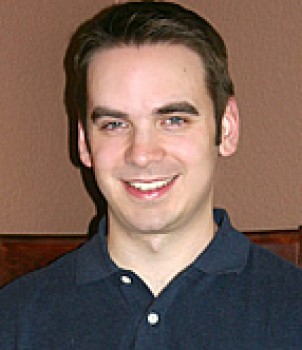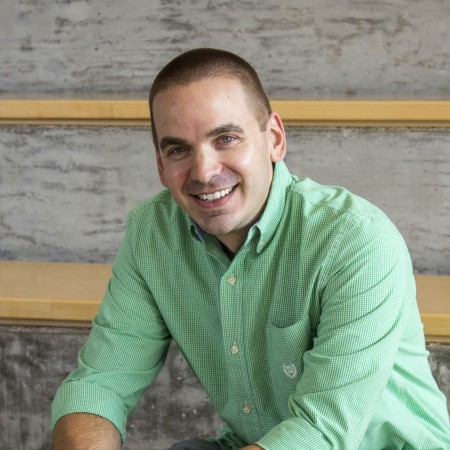M.S. - M.F.A., Digital Animation & Visualization
Ohio State University - 2002
Professional Preparation
B.S.D. - Industrial Design
Ohio State University - 2000
Ohio State University - 2000
Appointments
Assistant Professor
University of Texas at Dallas [2007–Present]
University of Texas at Dallas [2007–Present]
Visiting Assistant Professor
University of Texas at Dallas [2007–2007]
University of Texas at Dallas [2007–2007]
Lead Modeler
Element X Creative, Dallas, TX [2006–2007]
Element X Creative, Dallas, TX [2006–2007]
Freelance 3D artist
Various [2006–Present]
Various [2006–Present]
Adjunct Instructor
University of Texas at Dallas [2005–2006]
University of Texas at Dallas [2005–2006]
Head of Environment Modeling
DNA Productions, Irving, TX [2004–2006]
DNA Productions, Irving, TX [2004–2006]
Modeler/Rigger
DNA Productions, Irving, TX [2002–2004]
DNA Productions, Irving, TX [2002–2004]
Graduate Teaching Assistant
Ohio State University [2000–2002]
Ohio State University [2000–2002]
Additional Information
Professional memberships
- ACM Siggraph, 7/2009 – current
- Tex Graph, 7/2009 – current
Achievements in original investigation
- “Pilot: NSF CreativeIT Project: Collaborative Undergraduate Computing Studios Facilitating Decentralized Participation” August 2009 – August 2012 The goal of this project is to promote creativity in computationally intensive undergraduate design studios in which collaborators are not co-located. Systematic modifications will be made to team structure, workflow, and awareness technology employed by participants in successive undergraduate studio courses in order to understand the specific influence on technical and visual creativity. The students will be collaborating on projects with fellow participants and are neither co-located nor in a common time zone.
- Arts and Technology Curriculum Development: August 2007 – PresentA I am developing a modular approach to curriculum construction specific to Arts and Technology programs. This development takes into account both an entire technology program’s curriculum as well as the individual courses from which it is made. Explorations include the use of curriculum module units which can be reconfigured and coupled to create any number of courses from a single set of shared, common information nodes. Long distance and online education are also targeted.
- ATEC 3317 – Introduction to 3D Computer Modeling I have completed 2 complete 3317 course redesigns and am currently working on the third. These sections are taught nearly entirely by teaching assistants and adjunct instructors. The new course format and lessons are used by all instructors to ensure all of the students in all sections receive exactly the same information. This is a required course for all ATEC students and averages 4 sections per semester. The information covered builds the foundation required by nearly all subsequent ATEC courses. Areas covered include polygonal modeling, NURBS modeling, basic design skills and problem solving. Graduate and Undergraduate
- ATEC 3327 – Digital Lighting and Texturing I have completed 2 complete 3327 course redesigns and am currently working on the third. These sections are taught nearly entirely by teaching assistants and adjunct instructors. The new course format and lessons are used by all instructors to ensure all of the students in all sections receive exactly the same information. This is a required course for all ATEC students and averages 4 sections per semester. The information covered builds the foundation required by nearly all subsequent ATEC courses. Areas covered include UV unwrapping, lighting set ups and rigs, rendering and basic compositing. Graduate and Undergraduate
- ATEC 4348 – Advanced 3D Modeling I created this course from the ground up to introduce production modeling techniques that go well beyond those covered in the ATEC 3317 course. Graduate and Undergraduate
- ATEC 4349 – Advanced Digital Lighting and Texturing. I created this course to introduce production lighting, texturing and rendering techniques that go well beyond those covered in the ATEC 3327 course. Graduate and Undergraduate
- ATEC 4371 – Concept Design I created this course to allow students to develop their own animation, film and game concepts using real world production methodologies. Students develop their own production bibles including written treatments and log lines as well as conceptual artwork with an eye towards getting their idea produced. Graduate and Undergraduate
Service
- Nominated and Elected to the UT Dallas Arts and Humanities Executive Committee, August 2009
- Search Committee Chair for ATEC search number 1052: Assistant Professor of Virtual Environments and Online Worlds, Spring 2009
- Multiple career day presentations, Richardson ISD, January 2009
- The Trinity River Visualization: A Making Of, lecture and information presentation open to all ATEC students and faculty, January 2008
- Creating an Animate Short for Students, lecture and information presentation open to all ATEC students and faculty, October 2007
News Articles
ATEC School Draws Upon New Professors' Skills to Build Programs

The School of Arts, Technology, and Emerging Communicationsis beginning its first year with three new tenure-track faculty members who will help build new areas of study in the school.
One of the new faculty members studies digital culture and new media art, and the two new animation professors have extensive experience in the technical industry.
ATEC Prof Designs Robots for ‘Terminator’ Sequel
 An Arts and Technology (ATEC) faculty member has had a small stake in whether the next installment in the Terminator series flies or flops at the summer box office.
An Arts and Technology (ATEC) faculty member has had a small stake in whether the next installment in the Terminator series flies or flops at the summer box office.Todd Fechter, assistant professor of 3D computer animation with the ATEC program in the School of Arts and Humanities, spent the last two months working on components of a viral Web site which supports the upcoming Warner Bros. release, Terminator: Salvation.
